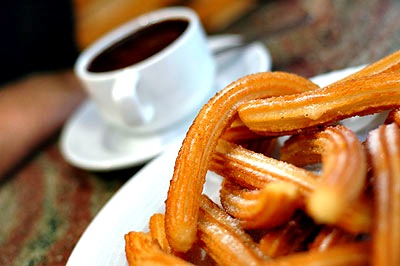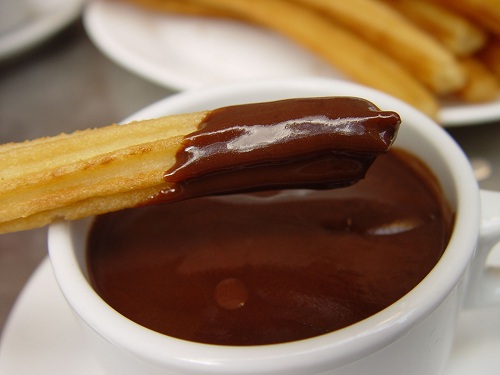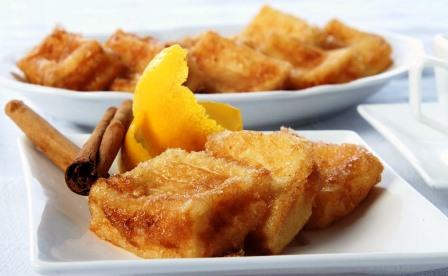Churros
Although churros are by no means exclusive to Madrid, they may have originated here. No open-air festival would be complete without its churrería stall, or at least a hawker wearing white cuffs and carrying a basket of freshly-fried fritters.
They are long thin strips of fluted dough fried to form loops. If thicker and straight, they are called porras, and if in the shape of a ring or hollow ball, buñuelos.
- Servings: 8
- Prep Time: 20 min.
- Cook Time: 5 min.

Ingredients
- 17 fl oz water
- 9 oz sifted flour
- 1 tsp salt
- Plenty of olive oil for frying
- Sugar (optional)
Preparation
Bring the salted water to a boil in a high-sided pot. When it starts to boil, pour in all the flour and mix with a wooden spatula over the heat until a consistent, even dough is formed. Remove from the heat and continue to work the dough with the same spatula. When completely smooth, fill the churrera, a large tin or brass syringe that has a variety of nozzles and several handles to grip it while pressing the dough through.
Heat the oil to 375 degrees F in a large frying pan and drop in strips of dough forming loops. Cook as many as will fit without touching each other. After 3-4 minutes, when golden, remove with a slotted spoon or a spike and leave to drain in a colander or on kitchen paper. Serve hot, sprinkled with sugar if desired.
You may be also interested in...
See also...
Chocolate a la taza (Spanish Hot Chocolate): Spaniards like their hot chocolate thick, so they let it simmer on the stove, stirring it all the while, until it has reduced to the correct density. The also believe that it tastes best when they are enjoying it with family or friends at one of the many places that serves hot chocolate and churros for breakfast. -
Leche frita (fried milk) is a traditional Spanish dessert recipe. It's quite easy to do, and the results are spectacular! If you want to impress your guests with a non-conventional, yet succulent dessert, try this easy recipe.




